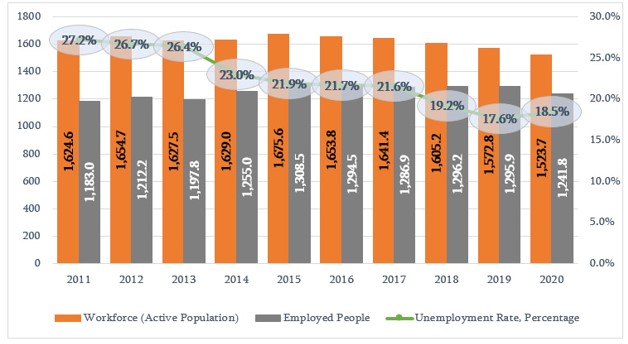Lasha Khutsishvili: “The unemployment rate was at historic minimum in 2019.”
Verdict: FactCheck concludes that the statement of the Minister of Finance is a MANIPULATION.
Resume: Unemployment has been one of Georgia’s biggest challenges even prior to the outbreak of the pandemic. The unemployment rate has been declining annually in the previous years and decreased to 17.6% in 2019. However, this was largely stipulated by the shrinking economically active population and not by some positive trends in employment. According to the unemployment level measurement methodology, if a person is no longer looking for a job he becomes a so-called “discouraged worker” which means that he ends up outside of the workforce and is no longer considered as unemployed. Therefore, the unemployment level decreases at the expense of the shrinking workforce and not because of a growth in employment.
The highest employment and workforce figures were registered in 2015. In 2016-2019, the workforce decreased by 102,800 and the number of employed people dropped by 12,600. In the same period, however, the unemployment rate dropped from 21.9% to 17.6% because of a decrease in the economically active population.
The Minister of Finance ignores the employment figures and the workforce decrease and seeks to highlight the unemployment rate as something positive which is erroneous.
Analysis
On 11 June 2021, the Minister of Finance of Georgia, Lasha Khutsishvili, made a statement at the plenary session of the Parliament of Georgia: “The unemployment rate has increased because of the pandemic’s impact. In 2019, the unemployment rate was in fact at a historic minimum for the country since gaining independence.”
Job losses have been one of the most serious problems during this period. This has been caused by the pandemic and the related stringent and prolonged economic restrictions. According to the National Statistics Office of Georgia, the unemployment rate increased by 0.9 of a percentage point in 2020 as compared to 2019 and reached 18.5%. In the same period, the number of employed people decreased by 54,100. The unemployment level increased particularly in the last quarter of 2020 and the first quarter of 2021. In fourth quarter of 2020, the unemployment rate reached 20.4% which is 3.8 percentage points higher as compared to the fourth quarter of 2019. In the first quarter of 2021, the unemployment rate increased by 3.7 percentage points as compared to the same period of the previous year and reached 21.9%. In the first quarter of 2021, the number of employed people decreased by 133,000 as compared to the first quarter of 2020.
Unemployment has been one of Georgia’s biggest challenges even prior to the outbreak of the pandemic. The unemployment rate (percentage figure) has been declining annually in the previous years although this was largely stipulated by the shrinking economically active population and not by some positive trends in employment. According to the methodology of the National Statistics Office of Georgia, the unemployment rate is measured by calculating the ratio of unemployed people and the economically active population (workforce). The workforce encompasses both employed people and those unemployed but looking for a job. A person who is unemployed but is not looking for a job (has not been looking for a job in the four weeks prior to the survey) ends up outside of the workforce and is no longer considered as unemployed. Frequently, these are the so-called “discouraged workers” who leave the ranks of the unemployed although they are not employed.
Technically speaking, the lowest unemployment level in 2010-2019 [1] was in 2019 which was stipulated by the shrinking economically active population instead of job growth. The highest number (1,675,600) of the economically active population (the total sum of those employed and those looking for a job) was registered in 2015. Since 2015, the workforce in Georgia has been declining annually, meaning that some people ended up outside of the workforce and the unemployment rate decreased without actually increasing employment. In 2016-2019, the workforce decreased by 102,800 and the number of employed people dropped by 12,600. In the same period, however, the unemployment rate dropped from 21.9% to 17.6% because of the decrease in the economically active population.
Graph 1: Employment and Unemployment in 2011-2020

Source: National Statistics Office of Georgia
[1] At the end of 2020, the National Statistics Office of Georgia adopted a new standard for the statistical compilation of employment and unemployment. As a result, the unemployment/employment statistics were recalculated from 2010. It is inappropriate to make comparisons with the years prior to 2010 whilst analysing data since the unemployment registration methodology is different.








